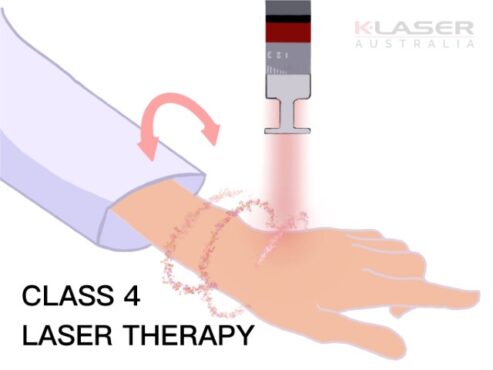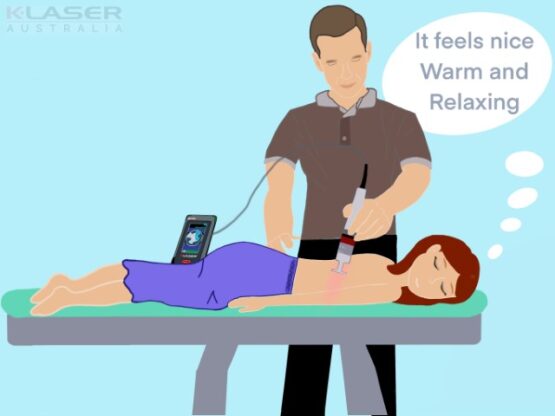Does Class 4 Laser
Burn Skin During Therapy
Or Not ?
The risk of Class 4 laser to burn is considered low for many reasons developed below. The heat factor of high-power therapeutic lasers (HILT) is often misunderstood. It is confused with heat generated by Class IV Surgical and Cosmetic lasers.
Class 4 Lasers have preset programs and used by trained health professionals.
Therefore, burns are unlikely to happen unless the laser unit is misused.

1- Does Class 4 Therapeutic Laser Overdose Tissues?
Laser therapy dosage is the quantity of energy (Joule) per area (cm2).
How fast the dosage is delivered (Irradiance in Watt/cm2) also interferes with the clinical results.
Laser overdosing refers to delivering a higher dose than required leading to potential negative effects on the tissue.
No damage at the cellular level
To our knowledge, publications studying possible cellular damage caused by laser therapy never reported any short or long-term damage.
This is mainly due to the source of radiation of laser therapy. Red and near-infrared wavelengths are non-ionising radiations.
On the contrary, X-Ray is a ionising radiation and is well known for its damaging effects on DNA cells. It is not the case with laser therapy. Laser therapy does not cause cancer.
Most adverse reactions and contraindications of laser therapy are common to Class 3b (<0.5W) and Class 4 ( >0.5W).
The warmth generated by high power Class 4 lasers implies extra attention with the treatment of heat-sensitive tissues. For example, teeth, brain, and growth plates.
Please see the full list of risks and contraindications with laser therapy below.
Same dosage with Class 4 and low-level lasers
Class IV laser therapy delivers a lot more joules than cold lasers. However, the same dosage is used with Class IIIb and Class IV lasers. Tissues are not overdosed. Class IV just targets a much larger area.
Example of a publication with a Class 3b low-level laser treatment for back pain.
TABLE 1 - D Stasinopoulos and al 2015 "LLLT for the management of patients with ankylosing spondylitis"
6 Points of 0.5cm2 on the back are treated with 4.5J each.
=> Total 27J over 3cm2
Each point of 0.5cm2 receives 4.5J => Fluence 9J/cm2
Irradiance = 60mW/cm2 = 0.06W/cm2
When compared with Class 4 Laser therapy on the lumbar area.
Area: Spine and muscles on each side: 15cm x 20cm = 300cm2
If we apply the article's Fluence (9J/cm2)
=> 2700 Joules delivered over 300cm2 in scanning motion
If we apply the article's Irradiance (0.06W/cm2) over the area:
=> 0.06 x 300cm2 = 18 Watts needed to keep the same irradiance
As an example the K-Laser presets for lumbar will only be 2500J with 10 W average power.
The scanning of large areas requires high power to keep a similar dose of irradiance or power density (W/cm2) of 0.06W/cm2
Class 4 laser burn is therefore not possible with such low irradiance.
2- What does the patient feels with Class 4 laser therapy?
Low-Level Laser therapy with high power (Class IV) laser can generate heat depending on several factors.
The patient will feel nothing or a gentle warmth as the laser beam is waved over the area.
The heat factors
We all agree that heat is not part of the photobiomodulation effect of laser therapy.
Heat is an additional effect of high power Class IV therapeutic lasers. But power is not the only factor influencing the heat generated.
The following factors influence heat:
- Average power during treatment.
- Speed of scanning motion vs fixed point.
- Quantity of melanin pigment in the skin.
- Pulsing or continuous wave mode.
- External chromophores such as tattoo pigments.
- Patients using photosensitizing drugs.
- Distance from the skin.

Warmth not present during every treatment
Class IV lasers can emit both low and high power, not only high power.
Please remember that high power is not required for every application.
K-Laser units are High-intensity lasers devices but the power emitted varies according to the applications.
For example acupuncture points settings, wounds settings, dental settings will vary from 0.1 W to 2-3 Watts.
However, carpal joints, Achilles, TMJD, elbows settings will vary from 3 to 7 Watts average. Finally, presets for deep tissues as back, neck, hip tend to vary from 5 to 15 W average power.
Consequently, it will take more time to feel the heat during the treatment of a wrist compared to the treatment of a neck or hip.
Similarly, heat is barely noticeable or absent during superficial treatment settings for wounds.
Advantages for the patient
Here are several points regarding Class 4 lasers with high power:
- Homogenous photobiomodulation of the area instead of targeting a few fixed points.
- Photobiomodulation on the whole injured site and its surrounding tissues.
- Time for the laser beam to cover all directions /angles around a joint not only one side (dorsal or medial).
- Faster treatment times allow the practitioner to treat several areas covering the injured site and tissues together with compensatory mechanisms.
- The patient feels a pleasant heat and feels that a beneficial laser treatment is happening.
- Patients enjoy the treatment because the warmth feels nice.
- Warming up tissues is helpful with muscle spasms. It is also useful with complementary treatment for pain management like Stretching, massage, and therapeutic exercises to name a few.
3- Does Class IV Laser therapy burn?
Class 4 surgical and cosmetic lasers are designed to burn the patient's skin. It is the opposite of Class 4 laser therapy aim.
So a burn is unlikely to occur for the 4 main reasons explained below.
The largest European Physiotherapy Department at Guy &
St Thomas LONDON Hospital explains K-Laser therapy in their education leaflet.
Laser technology with preset programs
K-Laser are high power lasers designed for health professionals.
As such, the software includes an easy to configure interface with preset programs.
Be aware that these presets are specific for the applications of each profession.
For example, the veterinary software is different from the software for a doctor, physiotherapist, podiatrist, or a dentist.
Therefore making dosage mistakes is very unlikely.
Some high-end models such as the K-Laser CUBE 30 can even detect a halt in the scanning motion of the practitioner's hand. This safety feature will automatically drop the power. Hence a burn from the laser device is not possible even on a fixed point.
Training from laser suppliers
More than ever, it is important to choose a laser supplier who provides a complete laser training.
In Australia, the K-Laser training always includes:
- Full laser safety training based on AU / NZ standards.
- Explains how to use the K-Laser software.
- Trains on how to implement recent publications into a K-Laser.
- Discuss the clinical protocols
- On-going access to the training course for new staff.
Common cases when training may not be available:
- The laser supplier only sell equipment without support.
- The practitioner purchase from overseas (grey import) or second hand.
Laser license for health professionals
In Australia, 3 states already regulate the use of medical lasers. Only health practitioners are eligible.
Most of the time health practitioners refer to doctors, nurses, and other medical professionals registered with AHPRA. Veterinarians and veterinary nurses can also access laser licensing.
Cost and insurance are other factors limiting the access of Class IV therapeutic lasers to unqualified people even in unregulated states.
Location / Therapeutic Lasers | Class 3b | Class IV |
|---|---|---|
Northern Territory | No Regulation | No Regulation |
Western Australia | Yes - Health Professionals | Yes - Health Professionals |
Queensland | No Regulation | Yes - Health Professionals |
South Australia | No Regulation | No Regulation |
New South Wales | No Regulation | No Regulation |
Victoria | No Regulation | No Regulation |
Tasmania | Yes - Health Professionals | Yes - Health Professionals |
ACT | No Regulation | No Regulation |
Patient feedback
It is important to understand that the heat generated is gradual / cumulative. It starts with gentle warmth on the skin after a few seconds. On a fixed point, a Class 4 laser beam can become hot in a few seconds if used at full power. This could only happen if the practitioner makes a mistake and forgets to move the handpiece which will cause the heat accumulate.
First, most of the time patients are awake to give feedback. This means that they will express their discomfort before any burn can happen to their skin.
Second, even during the treatment of animals, vets and nurses know the pet body language. In addition, it is very easy to touch the pet coat and estimate the warmth.
A more realistic risk could occur when patients are not able to feel and give feedback. For example, laser post-surgery when the patient is still under anesthesia. Or patients suffering from peripheral neuropathy or post-stroke.
Generally speaking, it is highly unlikely to choose a wrong dosage with the preset programs of the K-Laser. Please remember that Class 4 Laser therapy is performed by professionals who have received a complete laser training. Finally, the practitioners have developed experience along the years and know how fast to move the laser beam on specific areas.
For beginners, it is still possible to add extra precautions such as assessing the speed of scanning motion on their own skin for example. Another basic safety technique is to simply touch the patient's skin to feel how warm it is.
K-Laser specific safety measures to prevent mishandling
To ensure that Class 4 laser burns do not occur with their devices, K-Laser Australia provides appropriate training to the practitioners as well as an advanced laser technology and a user friendly software. The software automatically calculates optimal dosage to prevent mistakes. Therefore, involuntary misuse is improbable but burns are still among the list of possible side effects.
- K-Lasers units are TGA registered and designed with preset program specific to each health profession.
- Our latest model (Cube Plus 30) features an automatic detection system for the speed of the scanning motion and will reduce the power accordingly.
- Our Class 4 Laser safety course is based on AU/NZ Standards.
- Our Laser Therapy training is available at time of initial purchase and for new staff as well.
